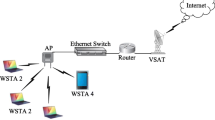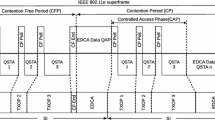Abstract
The real-time application is the main challenge that faces the wireless network. It must achieve the quality of service (QOS) requirements to success. IEEE802.11 standards use Enhanced Distributed Channel Access (EDCA) protocol and Distributed Coordinate Function (DCF) protocol in its Media Access Control (MAC) layer. EDCA protocol is used to overcome the drawback of supporting QOS in DCF protocol. The mechanism of EDCA protocol is based on dividing the data to four queues; voice, video, best effort and background. The queues have different priorities to access the medium. The voice queue has the highest priority and its data will serve firstly. Using the default parameter values for EDCA protocol will lead to increasing the collisions in the wireless network and decreasing the capacity. In this paper, the limitation of supporting QOS in EDCA protocol was presented by using OPNET simulation and mathematical model. The new mathematical model was designed by using Markov chain mechanism to evaluate the performance of the EDCA protocol under saturation and non-saturation conditions, aimed to separate between uplink and downlink throughput with different data types. Moreover, the new algorithm was proposed to enhance the capacity of the EDCA protocol and increase the number of the active voice users. Through our algorithm, the throughput was increased by 27.72% and the EDCA can support 14 voice users rather than 11 in the default EDCA protocol. The evaluation of our new algorithm was verified by using OPNET simulation and mathematical model.























Similar content being viewed by others
References
Hiertz, G. R., Denteneer, D., Max, S., Taori, R., Cardona, J., Berlemann, L., et al. (2010). IEEE 802.11 s: the WLAN mesh standard. IEEE Wireless Communications, 17(1), 104–111.
Ibánez, S. R., Santos, R. A., Licea, V. R., Block, A. E., & Ruiz, M. Á. G. (2008). Hybrid WiFi-WiMAX network routing protocol. IEEE 2008 electronics, robotics and automotive mechanics conference, pp 87–92.
Dahab, Y., Elmahdy, H., & Saroit, I. (2010). Improving the performance of IEEE 802.11 e using a dynamic adaptation approach. CiiT International Journal of Wireless Communication, 2(9), 276–280.
Abu-khadrah, A., Zakaria, Z., Othman, M., & Zin, M. S. I. M. (2015). Markov chain model for EDCA protocol under saturation and non-saturation conditions. Journal of Communications, 10(8), 596–602.
Ahemd, F. U., & Sarma, S. K. (2013). QoS and admission controller in IEEE 802.11e WLAN. 2013 4th international conference on intelligent systems, modelling and simulation, pp 468–471.
Tantra, J. W., Foh, C. H., & Bianchi, G. (2006). Analysis of the IEEE 802 . 11e EDCA Under Statistical Traffic. IEEE conference on Communications, pp 546–551.
Abu-Khadrah, A. (2015). Using Markov chain model to evaluate the performance of EDCA protocol under saturation and non-saturation conditions. International Review on Computers and Software, 10(3), 315–323.
Xiao, Y. (2005). Performance Analysis of Priority Schemes for IEEE 802.11 and IEEE 802.11e Wireless LANs. IEEE Transactions on Wireless Communications (I.RE.CO.S.), 4(4), 1506–1515.
Engelstad, P. E., & Osterbo, O. N. (2006). Analysis of the total delay of IEEE 802 . 11e EDCA and 802 . 11 DCF. IEEE international conference on communications, pp. 552–559.
Lee, J., & Lee, H. (2009). A performance analysis model for IEEE 802.11 e EDCA under saturation condition. IEEE Transactions on Communications, 57(1), 56–63.
Hwang, I.-S., & Chang, H.-H. (2008). Performance assessment of IEEE 802. 11e EDCF using three-dimension Markov chain model. Applied Mathematical Sciences, 2(3), 139–151.
Engelstad, P., & Østerbø, O. (2005). Non-saturation and saturation analysis of IEEE 802.11 e EDCA with starvation prediction. Proceedings of the 8th ACM international symposium on Modeling, analysis and simulation of wireless and mobile systems, pp. 224–233.
Liu, X., & Saadawi, T. N. (2011). IEEE 802.11e (EDCA) analysis in the presence of hidden stations. Journal of Advanced Research, 2(3), 219–225.
Kumar, S., Raghavan, V. S., & Deng, J. (2006). Medium access control protocols for ad hoc wireless networks: A survey. Ad Hoc Networks, 4(3), 326–358.
Stanica, R., Chaput, E., & Beylot, A. (2014). Reverse back-off mechanism for safety vehicular ad hoc networks. Ad Hoc Networks, 16, 210–224.
Hamidian, A., & Körner, U. (2006). An enhancement to the IEEE 802.11e EDCA providing QoS guarantees. Telecommunication Systems, 31(2–3), 195–212.
Sharma, G., Ganesh, A., & Key, P. (2009). Performance analysis of contention based medium access control protocols. IEEE Transactions on Information Theory, 55(4), 1665–1682.
Ray, S., Starobinski, D., Member, S., The, A., & Cts, R. T. S. (2007). On false blocking in RTS/CTS-based multihop wireless networks. IEEE Transactions Vehicular Technology, 56(2), 849–862.
Touil, H., Fakhri, Y., & Benattou, M. (2012). Energy-efficient MAC protocol based on IEEE 802.11 e for Wireless Multimedia Sensor Networks. In: IEEE international conference on multimedia computing and systems (ICMCS), pp 53–58.
Ferre, P., Doufexi, A., Nix, A., & Bull, D. (2004). Throughput Analysis of IEEE 802.11 and IEEE 802.11 e MAC. IEEE 2004 wireless communications and networking conference, pp. 783–788.
Koprivica, M. T., Ili, M. M., Neškovi, A. M., & Neškovi, N. J. (2011). An empirical study of the EDCA QoS mechanism for voice over WLAN. Telfor Journal, 3(1), 3–8.
Kosek-Szott, K., Natkaniec, M., & Pach, A. (2011). A simple but accurate throughput model for IEEE 802.11 EDCA in saturation and non-saturation conditions. Computer Networks, 55(3), 622–635.
Chern, H., Kuo, H., & Chou, S. (2012). Enhanced distribution chnnel access Modification of the intial & thereafter CW. Systems and Informatics (ICSAI), 2012 International Conference, (Icsai), 1397–1401.
Peng, F., Peng, B., & Qian, D. (2010). Performance analysis of IEEE 802.11e enhanced distributed channel access. IET Communications, 4(6), 728–738.
Tariq, A., & Perveen, K. (2010). Analysis of internal collision and dropping packets characteristics of EDCA IEEE802. 11e using NS-2.34 simulator. In Proceedings of the world congress on engineering and computer science (Vol. 1, pp. 20–23).
Abu-khadrah, A., Zakaria, Z., & Othman, M. (2015). New algorithm to enhance the capacity of EDCA protocol to tolerate more voice users by adjusting contention window. Advanced Science Letters, 21(1), 5–11.
Chatzimisios, P., & Raptis, P. (2008). Admission control for VoIP and data traffic in IEEE 802.11 WLANs. Proceedings of the 3rd international conference on performance evaluation methodologies and tools. ICST (Institute for Computer Sciences, Social-Informatics and Telecommunications Engineering), p. 78.
Harsha, S., Kumar, A., & Sharma, V. (2006). An analytical model for the capacity estimation of combined VoIP and TCP file transfers over EDCA in an IEEE 802.11 e WLAN. IEEE 2006 International Workshop on Quality of Service, 178–187.
Rea, S., & Pesch, D. (2004). Aperiodic cache provisioning for new network nodes in wireless mobile ad hoc networks. IEEE Conference in Vehicular Technology, 2004, 2878–2882.
Acknowledgements
All thanks to Allah and the authors would also like to thank UTeM for sponsoring this work under Zamalah Scheme and MOHE for the research grants, RACE/F3/TK8/FKEKK/F00251 and ERGS/2013/FKEKK/TK02/UTEM- E00021.
Author information
Authors and Affiliations
Corresponding author
Rights and permissions
About this article
Cite this article
Abu-Khadrah, A.I., Zakaria, Z., Othman, M. et al. Enhance the Performance of EDCA Protocol by Adapting Contention Window. Wireless Pers Commun 96, 1945–1971 (2017). https://doi.org/10.1007/s11277-017-4277-1
Published:
Issue Date:
DOI: https://doi.org/10.1007/s11277-017-4277-1




